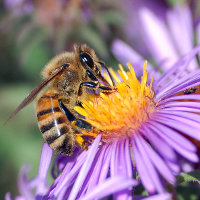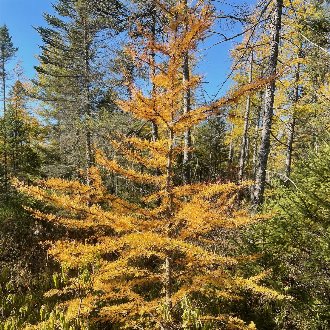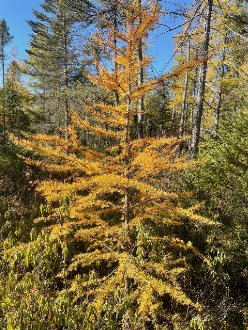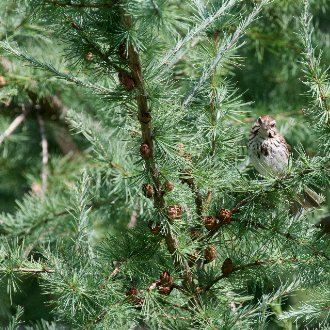Tamarack (Larix laricina (Du Roi) K. Koch)
Also known as hackmatack, eastern larch, American larch, black larch, red larch.
↑Summary
A deciduous conifer native across the northern reaches of North America, primarily found in acidic wetlands.
↑Range - Expand
| Legend | Color |
| Native or Not Present | |
| Native | |
| Introduced |
This tentative map is based on our own research. It may have limited data on Canada and/or Mexico, and there is some subjectivity in our assignment of plants as introduced vs. expanded. Read more in this blog post.
Although this plant occurs somewhere in each of these regions, it may only occur in a small part of some or all of them.
↑Habitat
Tamarack is a sun-loving tree mostly found in bogs and other acidic wetlands. Less commonly, it also occurs on dry upland sites, including sites with shallow soils over bedrock, and rarely, on high-pH mineral soils. It is usually a pioneer species.
It can grow on a wide range of soil conditions, but is most common on organic soils (histosols) such as peat made from sphagnum moss or wood. It is less common, but can occur on mineral soils. It tolerates all soil textures, from clay to coarse sand, and rocky soils or thin soils over bedrock, and is more tolerant of adverse soil textures than most trees. It is rare on, but can grow on calcareous soils.
In the southern portions of its range it is strictly limited to peatlands and bogs, but in the heart of its range it also occurs in less acidic wetlands, including fens, rich swamps. In Alaska it occurs on bogs underlain by permafrost. In the northern portions of its range, it also occurs on drier sites, especially north-facing slopes.
It most often associates with black spruce (Picea mariana), which shares its tolerance of poor drainage and acidic conditions.
Tamarack is a pioneer species, and is often the first tree to colonize open wetlands, where it sometimes colonizes mats of sedge or sphagnum moss, or is the first taller tree to colonize shrubby bogs. It also colonizes recently burned boreal forests, abandoned farmland, and clear-cut sites. It can persist indefinitely on sites where the conditions exclude other trees, but on most sites it is eventually replaced by other vegetation.
↑Life Cycle
Tamarack is a large tree with high light needs.
Trees growing in ideal conditions can (rarely) begin producing seed as early as 4 years of age, but more commonly, seed production starts around 12-15 years, but seed production is low until trees reach about 40 years of age. Production peaks around 75 years of age. Seed production on the harshest sites, such as peatlands in the north of its range, may be delayed even longer, with some trees not producing any seed until 50 years of age. Seed production often declines significantly after 150 years.
Seed crops are sporadic, with good crops occurring once every 3-6 years and only light crops in other years. Seeds are dispersed mainly by wind. Rodents eat much of the seed, and this pressure likely drives the tree's sporadic seed crop.
Seeds remain dormant over the winter, and germinate in the following spring, typically in May or June. Seeds germinate above the ground's surface.
Trees can reproduce vegetatively, both through layering, when a branch is covered by fast-growing moss or soil or sand moved by water or wind, or through root sprouts. Vegetative reproduction is the dominant form of reproduction at the extreme northern limit of trees in Canada and Alaska, but is less common farther south.
↑Links & External Resources
• Tamarack | Fire Effects Information System (FEIS) (About This Site)
• Larix laricina (Tamarack) | Illinois Wildflowers (About This Site)
• Larix laricina (Tamarack) | USDA PLANTS Database (About This Site)
• Larix laricina | Go Botany (About This Site)
• Larix laricina (Tamarack) | Missouri Botanical Garden Plant Finder (About This Site)
• Tamarack | Virginia Tech Dendrology Factsheets (About This Site)
• Tamarack | Silvics of North America (About This Site)
• Larix laricina | Biota of North America Project (BONAP) (About This Site)
• Larix laricina | NatureServe Explorer (About This Site)
• Larix laricina | Flora of North America (About This Site)
• Tamarack | Maryland Biodiversity Project (About This Site)





